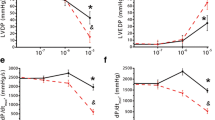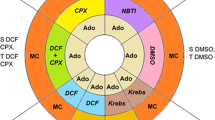Summary
The effects of the adenosine agonists (−)-N6-phenylisopropyladenosine (PIA) and 5′-N-ethylcarboxamideadenosine (NECA) on force of contraction, adenylate cyclase activity and normal as well as slow action potentials were studied in guinea-pig isolatedatrial (left auricles) andventricular preparations (papillary muscles).
Inauricles PIA and NECA exerted concentration-dependent negative inotropic effects with similar potenticies (mean EC50:0.05 μmol l−1 for PIA and 0.03 μmol l−1 for NECA). Similar results were obtained in the presence of isoprenaline.
Inpapillary muscles PIA and NECA alone had no effect on force of contraction but produced negative inotropic effects in the presence of isoprenaline (mean EC50:0.19 μmol l−1 for PIA and 0.10 μmol l−1 for NECA).
In both preparations, the negative inotropic effects of PIA and NECA in the presence of isoprenaline were antagonized by the adenosine receptor antagonist 8-phenyltheophylline.
In both preparations, PIA and NECA did not affect adenylate cyclase activity, both in the absence and presence of isoprenaline.
Inauricles the negative inotropic effects of both nucleosides were accompanied by shortening of the action potential. This effect was also observed in the presence of isoprenaline. Inpapillary muscles the adenosine analogs did not detectably alter the shape of the normal action potential. Ca2+-dependent slow action potentials elicited in potassium-depolarized preparations also remained unaltered in the presence of PIA or NECA alone. However, the isoprenaline-induced enhancement of the maximal rate of depolarization of slow action potentials was attenuated by PIA or NECA.
It is concluded that in guinea-pig atrial and ventricular cardiac preparations the adenosine analogs PIA and NECA exert isoprenaline-antagonistic effects on force of contraction via adenosine receptors the existence of which can thus be shown in a functional way. These receptors are not detectably coupled to the adenylate cyclase. The negative inotropic effect in theauricle is most likely due to a shortening of the action potential resulting from an activation of potassium channels, which in turn indirectly reduces the Ca2+ influx during the action potential. In theventricle the adenosine receptor is either not linked to these potassium channels or adenosine-sensitive potassium channels do not exist in the ventricle. Instead the activation of the receptor causes a decrease of the slow Ca2+ inward current but this effect is observed only when the slow Ca2+ inward current had previously been enhanced by a cyclic AMP-dependent mechanism.
Similar content being viewed by others
References
Bauer AC, Schwabe U (1980) An improved assay of cyclic 3′,5′-nucleotide phosphodiesterases with QAE-Sephadex columns. Naunyn-Schmiedeberg's Arch Pharmacol 311:193–198
Baumann G, Schrader J, Gerlach E (1981) Inhibitory action of adenosine on histamine- and dopamine-stimulated cardiac contractility and adenylate cyclase in guinea pigs. Circ Res 48:258–266
Belardinelli L, Isenberg G (1983) Isolated atrial myocytes: adenosine and acetylcholine increase potassium conductance. Am J Physiol 244:H734-H737
Berne RM (1963) Cardiac nucleotides in hypoxia: possible role in regulation of coronary blood flow. Am J Physiol 204:317–322
Böhm M, Brückner R, Hackbarth I, Haubitz B, Linhart R, Meyer W, Schmidt B, Schmitz W, Scholz H (1984) Adenosine inhibition of catecholamine-induced increase in force of contraction in guinea-pig atrial and ventricular heart preparations. Evidence against a cyclic AMP- and cyclic GMP-dependent effect. J Pharmacol Exp Ther 230:483–492
Böhm M, Burmann H, Meyer W, Schmitz W, Scholz H (1985) Positive inotropic effect of Bay K 8644: cAMP-independence and lack of inhibitory effect of adenosine. Naunyn-Schmiedeberg's Arch Pharmacol 329:447–450
Brückner R, Schmitz H, Scholz H, Schumacher A, Erdmann E, Krawietz W, Werdan K (1980) Negative inotropic effect of vanadate in ventricular myocardium in the presence of 3-isobutyl-1-methylxanthine or isoprenaline. Naunyn-Schmiedeberg's Arch Pharmacol 315:147–153
Brückner R, Fenner A, Meyer W, Nobis T-M, Schmitz W, Scholz H (1985) Cardiac effects of adenosine and adenosine analogs in guinea-pig atrial and ventricular preparations. Evidence against a role of cAMP and cGMP. J Pharmacol Exp Ther (in press)
Bruns RF, Daly JW, Snyder SH (1983) Adenosine receptor binding: structure activity analysis generates extremely potent xanthine antagonists. Proc Natl Acad Sci USA 50:2077–2080
Collis MG (1983) Evidence for A1-adenosine receptors in the guineapig atrium. Br J Pharmacol 78:207–212
Dobson JG Jr (1983) Mechanism of adenosine inhibition of catecholamine-induced responses in heart. Circ Res 52:151–160
Dönges C, Heitmann M, Jungbluth H, Meinertz T, Schmelzle B, Scholz H (1977) Effectiveness of theophylline to increase cyclic AMP levels and force of contraction in electrically paced guineapig auricles. Comparison with isoprenaline, calcium and ouabain. Naunyn-Schmiedeberg's Arch Pharmacol 301:87–97
Drury AN, Szent-Györgyi A (1929) The physiological activity of adenine compounds with especial reference to their action upon the mammalian heart. J Physiol (Lond) 68:213–237
Endoh M, Yamashita S (1980) Adenosine antagonizes the inotropic action mediated via β- but not α-adrenoceptors in the rabbit papillary muscle. Eur J Pharmacol 65:445–448
Endoh M, Maruyama M, Taira N (1983a) Modification by isletactivating protein of direct and indirect inhibitory actions of adenosine on rat atrial contraction in relation to cyclic nucleotide metabolism. J Cardiovasc Pharmacol 5:131–142
Endoh M, Maruyama M, Taira N (1983b) Adenosine-induced changes in rate of beating and cyclic nucleotide levels in rat atria: Modification by islet-activating protein. In: Daly JW, Kuroda Y, Phillis JW, Shimizu H, Ui M (eds) Physiology and pharmacology of adenosine. Raven Press, New York, pp 127–140
Evans DB, Schenden JA, Bristol JA (1982) Adenosine receptors mediating cardiac depression. Life Sci 31:2425–2432
Fox AC, Reed GE, Glassmann E, Kaltmann AJ, Silk BB (1974) Release of adenosine from human hearts during angina induced by rapid atrial pacing. J Clin Invest 53:1447–1457
Gilman AG (1970) A protein binding assay for adenosine 3′,5′-cyclic monophosphate. Proc Natl Acad Sci USA 67:305–312
Gubareff T de, Sleator W (1965) Effects of caffeine on mammalian atrial muscle and its interaction with adenosine and calcium. J Pharmacol Exp Ther 148:202–214
Hopkins SV (1973) The potentiation of the action of adenosine on the guinea-pig heart. Biochem Pharmacol 22:341–348
Hosey MM, McMahon KK, Green RD (1984) Inhibitory adenosine receptors in the heart: characterization by radioligand binding studies and effects on β-adrenergic stimulated adenylate cyclase and membrane protein phosphorylation. J Mol Cell Cardiol 16:931–942
Hughes PR, Stone TW (1983) Inhibition by purines of the inotropic action of isoprenaline in rat atria. Br J Pharmacol 80:149–153
Isenberg B, Belardinelli L (1984) Ionic basis for the antagonism between adenosine and isoproterenol on isolated ventricular myocytes. Circ Res 55:309–325
Jochem G, Nawrath H (1983) Adenosine activates a potassium conductance in atrial heart muscle. Experientia 39:1347–1349
Kruse E, Scholz H (1978) Effect of theophylline on myocardial adenylate cyclase activity. Experientia 34:504–505
Lohse MJ, Lenschow V, Schwabe U (1984) Two affinity states of adenosine Ri receptors in brain: Analysis of guanine nucleotide and temperature effects. Mol Pharmacol 26:1–9
Lohse MJ, Ukena D, Schwabe U (1985) Demonstration of Ri-type adenosine receptors in bovine myocardium by radioligand binding. Naunyn-Schmiedeberg's Arch Pharmacol 328:310–316
Londos C, Wolff J (1977) Two distinct adenosine-sensitive sites on adenylate cyclase. Proc Natl Acad Sci USA 74:5482–5486
Londos C, Cooper DMF, Wolff J (1980) Subclasses of external adenosine receptors. Proc Natl Acad Sci USA 77:2551–2554
Lowry OH, Rosebrough NJ, Farr AL, Randall RJ (1951) Protein measurement with Folin phenol reagent. J Biol Chem 193:265–275
McKay D (1978) How should values of pA2 and affinity constants for pharmacological competitive antagonists be estimated? J Pharm Pharmacol 30:312–313
Meinertz T, Nawrath H, Scholz H (1973) Influence of cyclization and acyl substitution on the inotropic effects of adenine nucleotides. Naunyn-Schmiedeberg's Arch Pharmacol 278:165–178
Rockoff JB, Dobson JG Jr (1980) Inhibition by adenosine of catecholamine-induced increase in rat atrial contractility. Am J Physiol 239:H365-H370
Schmitz W, Hackbarth I, Scholz H, Wetzel E (1980) Effects of vanadate on the c-AMP system of the heart. Basic Res Cardiol 75:438–443
Schmitz W, Böhm M, Hackbarth I, Schmidt B (1982a) Effects of adenosine on force of contraction and the cAMP and cGMP content in guinea-pig hearts in the presence of isoprenaline. Naunyn-Schmiedeberg's Arch Pharmacol 319:R 38
Schmitz W, Fenner A, Hackbarth I, Meyer W, Nobis T-M, Scholz H (1982b) Effects of adenosine, N6-phenylisopropyladenosine and 2′,5′-dideoxyadenosine on force of contraction and cyclic nucleotides in the mammalian heart. International Symposium on Adenosine, Charlottesville, USA. Summaries of Presentations and Abstracts of Posters, 205
Schmitz W, Böhm M, Brückner R, Burmann H, Meyer W, Neumann J, Nose M, Scholz H (1985) Relationship between the effects of cAMP-increasing agents and adenosine in the mammalian heart. In: Stefanowich V (ed) Pharmacology of adenosine and xanthine derivatives. IRL Press, Oxford, in press
Schrader J, Baumann G, Gerlach E (1977) Adenosine as inhibitor of myocardial effects of catecholamines. Pflügers Arch 372:29–35
Schütz W, Tuisl E (1981) Evidence against adenylate cyclase-coupled adenosine receptors in the guinea pig heart. Eur J Pharmacol 76:285–288
Schwabe U (1983) General aspects of binding of ligands to adenosine receptors. In: Berne RM, Rall TW, Rubio R (eds) Regulatory functions of adenosine. Martinus Nijhoff Publishers, The Hague Boston London, pp 77–96
Ukena D, Poeschla E, Schwabe U (1984) Guanine nucleotide and cation regulation of radioligand binding to Ri adenosine receptors in rat fat cells. Naunyn-Schmiedeberg's Arch Pharmacol 326:241–247
Van Calker D, Muller N, Hamprecht B (1979) Adenosine regulates by two different types of receptors the accumulation of cyclic AMP in cultured brain cells. J Neurochem 33:999–1005
Watanabe AM, Besch HR (1974) Cyclic adenosine monophosphate modulation of slow calcium influx channels in guinea-pig hearts. Circ Res 35:316–324
Webster S, Olsson RA (1981) Adenosine regulation of canine cardiac adenylate cyclase. Biochem Pharmacol 30:369–373
Author information
Authors and Affiliations
Rights and permissions
About this article
Cite this article
Böhm, M., Brückner, R., Meyer, W. et al. Evidence for adenosine receptor-mediated isoprenaline-antagonistic effects of the adenosine analogs PIA and NECA on force of contraction in guinea-pig atrial and ventricular cardiac preparations. Naunyn-Schmiedeberg's Arch. Pharmacol. 331, 131–139 (1985). https://doi.org/10.1007/BF00634229
Received:
Accepted:
Issue Date:
DOI: https://doi.org/10.1007/BF00634229




